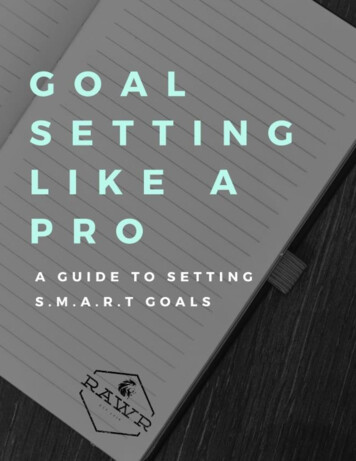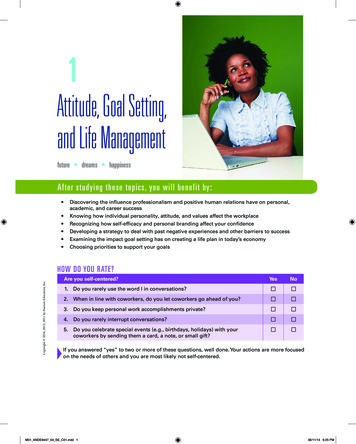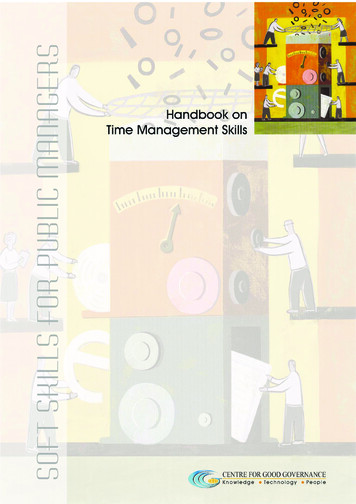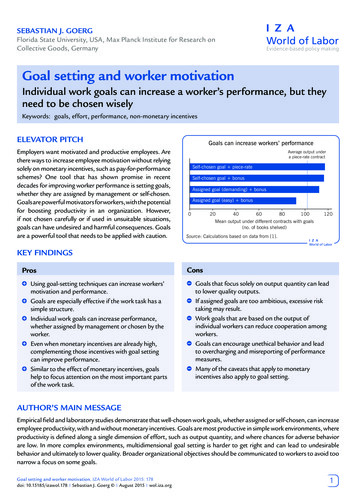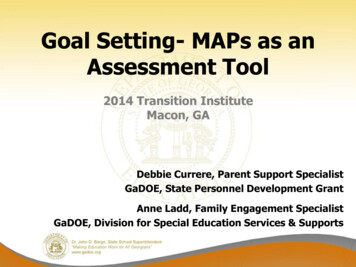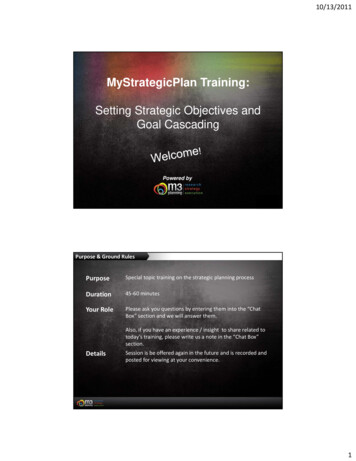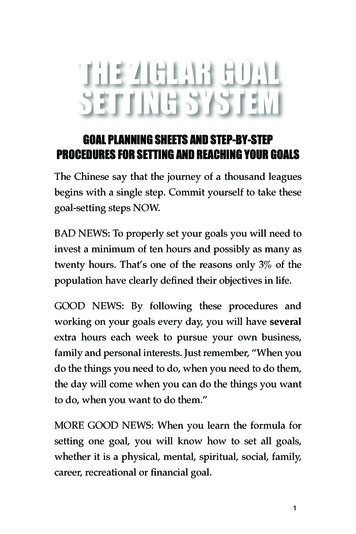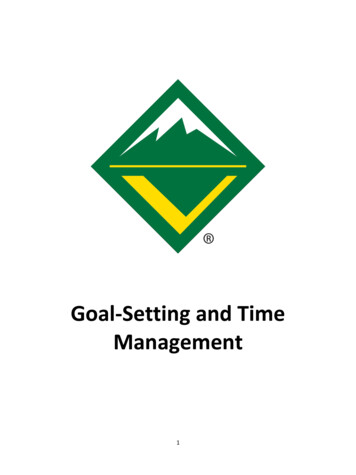
Transcription
Goal-Setting and TimeManagement1
Goal-Setting and Time ManagementPURPOSE: This course is a requirement for the Venturing Discovery Award; however, it can betaken, at any time, by Venturers whether they are working on the award or not. This course canbe presented as a workshop for single or multiple crews or broken into shorter segments andpresented at crew meetings or Venturing Forum/Roundtables. The small group approach usedin this training can be adjusted to accommodate any number of participants. It is highlysuggested that this course be taught by more experienced Venturers as well as adult volunteersparticipating in the program.OVERVIEW: Finding a successful time management strategy depends on a person’s personality,ability to self-motivate and level of self-discipline. This course introduces established methodsfor improving a Venturer’s ability to effectively manage the events in his or her life in relation totime.LEARNING OBJECTIVES: Venturers will: Increase their awareness of time management strategiesImplement self-selected strategiesPredict external time wastersExamine how they spend their timeModel how to set prioritiesOrganize tasks by categoryAssess the importance of using a planning toolPerform work in a timely mannerSchedule time appropriatelyTIME: Approximately 3 ½ hours. This training can also be divided and presented as individualmodules.INSTRUCTIONAL TECHNIQUES: guided discussion, individual and group activities,demonstration, and small group discussionINSTRUCTIONAL MATERIALS: Flipchart and markersBlank paperPens or pencilsLarge clear jarMedium-sized rocks (or golf balls)Gravel or pebbles (or marbles)Seeds (or beads)Sample planning tools, e.g., calendars, “To Do” lists, phone, diaries, work logs, etc.(optional)Separate sheets of 8 1/2” x 11” paper, labeled: ALWAYS, SOMETIMES, RARELY
TapeHandouts from appendixComputer, with internet access connected to a projectorREFERENCES: Covey, Sean (1998). The 7 Habits of Highly Effective Teens. New York: Touchstone. Covey, Stephen R. (1989). The 7 Habits of Highly Effective People. New York: Free Press. Covey, Stephen R., Merrill, A. Roger, & Merrill, Rebecca R. (1994). First Things First: ToLive, to Love, to Learn, to Leave a Legacy. New York: Simon and Schuster.Lakein, Alan (1989). How to Get Control of Your Time and Your Life. New York: Signet. Tracy, Brian (2001). Eat That Frog!: 21 Great Ways to Stop Procrastinating and Get MoreDone in Less Time. San Francisco: Berrett-Koehler Publishers, Inc.AGENDASessionTimeIce Breaker10 minutesCourse Introduction5 minutesTracking Your Time40 minutesBreakSetting Priorities10 minutes40 minutesBreakGetting OrganizedBreak10 minutes40 minutes10 minutesUsing Planning Tools15 minutesBeating Procrastination15 minutesScheduling Your Time10 minutesCourse Summary5 minutesTotal Time3 ½ hours (210 minutes)
ICE BREAKER – TIME ROBBERS (10 min)Materials needed Individual signs labeled: ALWAYS, SOMETIMES, RARELYtapeDirections1. Before the course begins, tape the signs along one wall of the room.2. Explain that there are many activities we do during the day that fill our time, some ofthem are productive, others are not.3. Tell participants that you will name an example of a “Time Robber”—an activity that isunproductive. Instruct them to move to the sign that represents how often this “TimeRobber” affects them. Realize that participants will be moving with each example yougive. Instruct participants to move in an orderly manner.4. Explain that these are examples of distractions that can cut into the time when theyshould be doing something else.5. Have Venturers who get distracted explain how the “Time Robber” affects their abilityto get done what they need to do.6. Close the activity by asking for suggestions on how to better handle time robbers.Examples of Time Robbers: (Select a few or all of these items. You may also add additionalexamples that are not on the list.) Chatting or texting Unexpected visitors Doing tasks that others are capable of and willing to do Doing nothing while standing in line Doing nothing while riding on public transportation or as a passenger in a car Not planning ahead for meals Going to routinely scheduled meetings Checking e-mail when the alert prompts that you have a message Frequenting social networking sites (Facebook, Twitter, Pinterest, Instagram, Google ,Tumblr, etc.) Surfing the Internet Watching TV Hitting the snooze button on the alarm clock to get up at the last minute possible Shuffling toys, food, work, etc. from one table or area to another without puttinganything away Not planning your day Running errands without thinking about optimizing your trip time
OPTIONAL METHOD OF PRESENTING THE ACTIVITYDivide participants into 5 groups. Assign each group one of the following time wasters:phone/social media; meetings; e-mail; family obligations; and friends/visitors. (If you havefewer than 5 groups; assign more than one time waster to each group.) Have each groupformulate solutions to manage their time waster and list them on a flipchart. If participantshave internet access, have groups create a “word cloud” of their suggested solutions. Haveeach group select a spokesperson to share their list.Guide participants to p.49 in the Handbook for Venturers. Have each group evaluate their listof time wasters and assess each to determine which tip might help them effectively managetheir time.COURSE INTRODUCTION (5 min)Here’s a riddle - You can’t save it, you can’t borrow it, you can’t lend it, you can’t leave it, youcan’t take it with you, you can only do two things with it – use it or lose it. What is it? Theanswer is TIME! You only have 24 hours, 1,440 minutes or 86,400 seconds each day. How youuse that time depends on skills learned through self-analysis, planning, evaluation, and selfcontrol.What is Time Management?Time management refers to a range of skills, tools, and techniques used to manage events inyour life in relation to time. Time management is really a misnomer. We don’t really managetime – we manage ourselves and our life events in relation to time.We just looked at a few ways we waste our time. Now, we‘ll explore strategies that can helpyou more effectively manage events in your life in relation to time. Finding strategies that workbest for you depend on your personality, culture, circumstances, and priorities, but you mustlook critically at yourself and perhaps confront some difficult issues.Guide participants to p.49 in the Handbook for Venturers. Tell them that these TimeManagement guidelines will help them as they work through the next activity.TRACKING YOUR TIME (40 min)Strategy 1 Be Time-Aware – You cannot manage time well without being aware of how longthings take and how you are using your time. Improve your time management skills byunderstanding how you use your time.IntroductionHave the Venturers calculate how many minutes there are in a year and then, roughly, howmany minutes they have been alive. (Answer – 525,600 minutes in year which averages out to7,884,000 minutes for a 15 year-old).
Point out that how they use their time is one way they can help themselves reach theirpersonal goals (including Venturing recognition goals!).ACTIVITY – Where Does the Time Go?Materials Needed: Chart paper and markers Appendix A, How Do I Use My Time? worksheet Appendix B, Daily Time Log Directions HandoutInstructions1. Distribute the How Do I Use My Time? worksheet and explain that they are going to beworking independently on all three sections of the worksheet, but will have time todiscuss the sections with a partner.2. Assign partners.3. Instruct Venturers to complete the following:a. Part I of the worksheet addressing how they spent their time yesterday.b. Part II of the worksheet asking them to rate how well they manage their time inrelationship to school, studying, and homework.4. Stop at this point and collect data from the Venturers concerning Part I and Part II of theworksheet.a. How much time did they spend on the computer, communicating with friends, orwatching TV? Have one of the Venturers determine an average.b. How much time did they physically spend with their friends? Have one of theVenturers determine an average.c. Ask the Venturers to turn and talk with a partner (or partners if there are anuneven number of participants) about where they wish they had spent theirtime when they look back from today’s perspective.5. Next, draw their attention to Part III of the worksheet. Ask the Venturers to work withtheir partner to determine the following:a. What activity is the most important and how much time should it take up duringtheir day?b. What is next most important activity and how much time should it get?c. And finally, what is the least important activity and how much time will it get?6. Encourage the Venturers to ask each other questions about their priorities and toexpect that their answers may be different.7. Answer code: Scale for PART II of the Time Analysis worksheeta. 12 – 15 Points Great: You have awesome study and time management skills.
b. 7 – 11 Points Okay: You have some good habits, but they can use a littleimprovement.c. 6 or below Needs Improvement: You can use some help with your study habits.8. Distribute the “Using a Log to Determine How You Spend Your Time” handout andexplain that they can use this information to perform a more thorough analysis of theirtime on their own.9. Suggest that this plan should be shared during the Advisor Conference. Conclude thesession by asking what they have found most interesting or most meaningful about howVenturers in this group use their time.SETTING PRIORITIES (40 min)Strategy 2 – The key to prioritization is determining the most important thing to do to reachyour goals.DEMONSTRATION: Big Rocks in a Jar! (Adapted from Stephen R. Covey) (10 min)Materials Needed: Large glass or clear plastic jar Medium-sized rocks Small pebbles Sand (Note: you can replace rocks, pebbles, and sand with golf balls, marbles, and smallbeads.)Instructions1. Show an empty jar to the participants and say “This jar represents your time.”2. Add rocks to the jar until you cannot add any more. “The rocks are the goals andcommitments that are important to you.” Ask those who believe the jar is full to stand.3. Now add pebbles to the jar. “The pebbles represent things that you want to do, butdon’t need to do. They matter to you, but not as much as your goals and commitments.Notice that there is room for them in the jar as they fill in the gaps around the rocks.4. Next add the sand until the jar appears to be full. “The sand represents all the small,unimportant time-taking tasks that are easy, and quick, to do.”5. Ask, “What is the point of this demonstration?” Venturers may say that no matter howfull your schedule, you can always fit more into it. This would be incorrect.6. Make the point that the real moral of this exercise is that you can make time for yourbig rocks, but only if you put them into the schedule first and then fit everything elsearound and between the rocks. It may be easier to pour the smaller things into the jar,but if they fill too much of the jar there will be less room for the big rocks.
7. Ask, “So what will you fill your jar with for the rest of the day?” Create a word cloudwith their responses and post it to your crew’s website.ACTIVITY: Time Management Matrix - Determining your Priorities (30 min)Materials Needed Flipchart and markers Pen/pencil and paper Appendix C (for instructor only)Instructions1. Explain that managing your time effectively requires an understanding of the distinctionbetween what is important and what is urgent.2. Ask Venturers what the difference is between important and urgent. Guide them to theunderstanding that:a. Urgent means it requires immediate attention – it cannot be put off withoutcreating problems. Urgency may affect others.b. Importance has to do with results. If something is important to you, itcontributes to your mission, goals and/or values. It is important to understandthat what is important to one person, may not be important to another.Importance is personal.3. Introduce the matrix by explaining that we can divide tasks into four quadrants based onwhat is urgent and what is important.4. Draw and label the matrix on a flipchart and explain:a. Quadrant 1 (Urgent and Important) Where our priorities should be.b. Quadrant 2 (Not Urgent, but Important) Items in this quadrant allow you to beproactive. You should spend most of your time working on items in thisquadrant.c. Quadrant 3 (Urgent but Not Important) These items could be someone else’simportant items.d. Quadrant 4 (Not Urgent and Not Important) These items are considered busywork. You may use these items as an escape.
ImportantNot ImportantUrgentNot UrgentIIIUrgent and ImportantNot Urgent, but ImportantIIIUrgent, but Not ImportantIVNot Urgent and NotImportant5. Break into groups of 3-5 Venturers. Ask each group to identify three or more typicaltasks and activities that fall into each quadrant.6. Debrief by having Venturers discuss the following:a. Where they should spend most of their time (in the Important quadrants-Quadrants 1 and 2, and especially spend more time in long-term activities).b. Which quadrant(s) they should avoid (the not important ones, especially the onethat is also not urgent).7. Summarize with the following:a. The most important tasks usually are not the most urgent tasks. Yet we tend tolet the urgent tasks dominate our lives.b. While activities that are both urgent and important must be done, StephenCovey suggests that we spend less time on activities that are not important(regardless of their urgency) in order to gain time to focus on activities that arenot urgent, but important.c. Focusing on these important activities allows you to gain greater control overyour time and possibly reduce the number of important tasks that do becomeurgent.8. Note: See Appendix D for additional information
GETTING ORGANIZED (40 min)Strategy 3: Removing the clutter and getting organized are valuable tasks.Here’s an interesting fact - Time management experts say that we spend about 7 hours perweek just looking for things or being distracted by clutter (Missouri Business DevelopmentProgram, 2009).Whenever you feel overwhelmed by too many things to do and too little time in which to dothem, sit down, take a deep breath, and list all those tasks you need to accomplish.There are three basic options for handling information: Act on it Delegate it Eliminate itActBefore you begin your tasks, you should assign priorities to them: A highest importance and/or urgency B medium importance and/or urgency C lower importance and/or urgencyIf you have more than one “A” priority - mark them A1, A2, A3, etc. Do the same for your B andC priorities.DelegateAsk yourself if the task is something you must do personally or if you can delegate this task tosomeone else who can do the job.EliminateSome tasks may not need to be done at all. You should eliminate every single activity youpossibly can, in order to free up your time. Some questions to ask yourself before you eliminatea task are: Do I really need it? How will it help me? Will it be useful when I need it again? Is it new or unique? Is it a necessary part of a project or special file (e.g., personnel file, client file, schoolrecord, tax related, etc.) Would it be difficult to replace? Could anything bad happen if I toss it?Efficiency is doing things the right way. Effectiveness is doing the right things. Your ability toplan and organize your work, in advance, so you are always working on your highest value tasks
determines your success as much as any other factor – Brian Tracy, CEO Brian TracyInternational, specializing in training and developmentACTIVITY: Lighten your Backpack (30 min)An easy way for remembering how to set priorities is to think of what we have just covered asthe “A-B-C-D-E method”. The following activity will help you practice the “A-B-C-D-E” method”.Create a list of your goals and objectives and before you begin, place one of those letters in themargin before each of the tasks on your list.Materials: Appendix E, A-B-C-D-E Method HandoutAppendix F, Lighten Your Backpack WorksheetDirections1. Read the following scenario: You have been a member of your Venturing crew foralmost a year. You are the activity chair for the upcoming camping trip scheduled fourweeks from now. This is a popular crew adventure because it is held at a state park 40miles away allowing crew members to choose between mountain biking or horsebackriding. The stables have told you that they can only reserve 8 horses per group and thatreservations are on a first-come basis. Mountain bikes are also available at the park forrent, if needed.2. Break into groups of two or three.3. Distribute the A-B-C-D-E Method Handout and Backpack Activity Sheet and askVenturers to assign priorities to the items.4. Explain that they will have 15 minutes to scan through every item on the list and assignpriorities to each. Have them be prepared to discuss their rationale with the group.5. Have Venturers evaluate whether there are other tasks related to the items listed. If so,have them identify and include those tasks.6. After 15 minutes engage the group in a discussion of the following: Describe any itemsyou could delegate. Were there any items that needed to be eliminated? Identify anyadditional tasks not listed that needed to be considered.7. Ideas to take away from this exercise that will help you stay organized and on task:a. Take the time to be clear about your goals and objectives so that the prioritiesyou set are moving you in the direction of something that is of real value to you.b. Remember that what counts is not the amount of time that you put in overall;rather, it’s the amount of time that you spend working on high-priority tasks.c. Understand that the most important factor in setting priorities is your ability tomake wise choices. You are always free to choose to engage in one activity oranother.
USING PLANNING TOOLS (15 min)Strategy 4 – Using a planning tool improves your productivity.Keeping a reliable, easy-to-use record of upcoming events, meetings, and appointments iscrucial for time management. There are many types of planning tools available, so find one thatyou enjoy using.Materials: Examples of planning tools (optional)DISCUSSION: Ask Venturers if they use planning tools. Lead a discussion on how a planning toolis used. (See appendix for suggestions.) You may also want to have the Venturers showexamples of their favorite planning tools.To Do or Not To DoProbably the most common planning tool is the “To Do” list for noting items that we want tocomplete and when they need to be completed. Items on our “to do” list may come from avariety of sources, such as teachers, coaches, family members, or from your own goals andactivities. Most planning tools now incorporate the basic “to do” list.Many of us feel a great sense of accomplishment when we can cross an item off our list. Somehelpful points when using a “to do” list are: Check your list every day, usually at the beginning of the day. Cross off items immediately upon completion. At the end of the day, remember to transfer incomplete items. Assign priority rankings to items. Combine related tasks whenever feasible.Here’s a hint; you can make your “to do” lists more powerful if you assign a priority to each ofthe tasks, as learned in the previous section on organization. Remember A, B, C, D, and E?BEATING PROCRASTINATION (15 min)Strategy 5: Putting things off results in poor time management. Take a poll to determine the number of Venturers who put off tasks because they areoverwhelming or unpleasant. Think about why you put off making decisions.Share that often procrastinators just don’t want to deal with the reality of a situation or thework it might create for them. Whatever the situation, procrastination hinders a person’s abilityto manage time.Procrastination has other costs too: Health – procrastinators have more colds, flu, gastrointestinal problems, and insomniaTeamwork – procrastinators shift responsibilities onto others who become resentful
How to Stop Procrastinating Break the task down into smaller segments. Complete a preparatory task to help you get started—organize notes. Reward yourself for completing smaller tasks.DISCUSSION: Ask Venturers to think of a time when they put off doing something that neededto be done. Break into groups of two or three and discuss ways they might avoidprocrastinating in the future. Have groups share a few examples with the group. Ideas mayinclude: Do the least enjoyable thing first. Study for your hardest class or do a chore you dislikeand get it out of the way. Think small. Set small goals. Need to clean your room? Focus on one bookshelf or onecorner at a time. Reward yourself as you finish each goal. Set a timer, and work on a chore or task for just 10 or 15 minutes at a time. Say, "I choose to" instead of "I have to." We often rebel when we feel we "should" dosomething. Jump in! Stop waiting for the right moment or talking about what you're going to do-“Just do it!” Poke holes in the project by doing easy, quick tasks first Remove distractions. Remember to praise yourself about your progress. Aim for the exceptional but allow yourself to be pleased with good enough. Celebrate small accomplishments. Reward yourself for small steps as you work towardthe final product.SCHEDULING YOUR TIME (10 min)Strategy 6: Carefully scheduling your time can lead to having more time.“There is always enough time for the important things. The busiest people are able to find timefor what they want to do, not because they have any more time than others but because theythink in terms of ‘making’ time by careful scheduling.”Alan Lakein, time management expertThe 80:20 Rule This is neatly summed up in the Pareto Principle, or the '80:20 Rule'http://en.wikipedia.org/wiki/Pareto principle . This argues that typically 80% of effortgenerates only 20% of results. The remaining 80% of results are achieved with only 20%of the effort. While the ratio is not always 80:20, this pattern recurs so frequently as tobe the norm in many areas.
By applying the time management tips and skills in this section you can optimize youreffort to ensure that you concentrate as much of your time and energy as possible onthe high payoff tasks. This ensures that you achieve the greatest benefit possible withthe limited amount of time available to you.OPTIONAL HANDOUT: Appendix G, Time Management StrategiesNote: this is an optional activity – you may want to discuss and/or distribute this article on howsuccessful teens manage their time.COURSE SUMMARY (5 min)Practicing good time management skills results in higher levels of productivity, more energy,less stress, the ability to get things done, positive relationships, and increased self-esteem.What we have learned 1. Analyze where your time is spent2. Distinguish what is important and urgent3. Utilize tools to improve time management4. Schedule!5. Complete work in a timely manner6. Control time wastersGuide Venturers to conclude that time management skills can help them reach their goals. Forexample; suppose you want to raise your grade in math. You might schedule a set time eachday for study or tutoring, rather than just saying, "I'll study harder."FINAL ACTIVITY: Have Venturers choose a goal that they have had difficulty reaching. Helpthem formulate objectives for their goal in relation to managing their time for it. Each objectiveshould be specific, measurable, realistic, and have a completion date.Conclude with the following: Time management is really just a fancy way of describing balancing more than oneresponsibility at once. Like any other skill, it takes practice. The most difficult aspect of time management is holding yourself accountable forpracticing the skills you’ve learned. Regularly assess your progress to be sure you are meeting the goals you defined withinthe timeframe you established. Frequently ask yourself, “What is the best use of my time right now?” Routinely check tosee if you’ve kept the commitments you made to yourself and others.
AppendixAppendix A – Worksheet: How Do I Use My Time?Page 14Appendix B – Using a Log to Determine How You Spend Your TimePage 15Appendix C – Urgent/Important ChartPage 16Appendix D – Day PlannerPage 17Appendix E – The ABCDE Method for Setting PrioritiesPage 18Appendix F – Backpack Activity SheetPage 19Appendix G – Time Management StrategiesPage 2015
Appendix AWorksheet: HOW DO I USE MY TIME?Part I. Evaluate the last 24 hours and calculate how many minutes you spent on each of thefollowing activities. You may add other activities as needed.minutes sleepingminutes with my familyminutes eatingminutes watching TVminutes readingminutes communicating withfriends (chat, text, Facebook, phone, inperson, etc.)minutes on Venturing activitiesminutes playing or practicingsportsPart II. Now let’s examine how you spend your time on schoolwork. Read each statementbelow. If your response to the statement is always, give yourself a 3. If your answer issometimes, give yourself a 2. If your answer is probably not, give yourself a 1.1. I have a dedicated time for studying each day.2. I keep track of my assignments and regularly check for progress.3. I always prepare any materials I may need before I begin to study.4. I rarely get distracted when studying.5. I undertake assignments in chunks to avoid last minute work.Part III. Reflect on how you answered the questions above and fill out the chart below.Things that I Could do onlySometimes, not Every DayThings that I Need to doRegularly Every DayImportant Things thatNeed More TimeNotes:
Appendix BUsing a Log to Determine How You Spend Your TimeCreate and maintain a daily log of how you spend your time. You may be surprised at how muchtime you spend on various tasks or how much time is spent with phone calls and interruptions.The time log can provide you with a starting point for determining focus areas forimprovement.How long you keep the time log depends on the nature of your work. For most people, keepingthe log for seven consecutive days (one week) will suffice; for others, it may require a month ortwo. Divide your day into chunks of 15-30 minutes (perhaps even smaller, if more appropriatefor your schedule).Record exactly how you spend your time – be specific. Log your time as you go, not at the endof the day. You may not be recording every 15 minutes, only every time you shift yourattention.Try not to change your behavior during this time, even if you see obvious areas where you cangain better control – similar to keeping a food diary when you are on a diet. Rather, strive to geta realistic picture of your typical schedule.After completing the time log, assess your tasks and separate them into categories according tothe nature of each. For example, you may use categories such as homework, meetings, socialmedia, phone calls and texts, school, planning, exercising, sleeping, working, extra-curricularactivities, sports, etc. Calculate the percentage of time spent on each category. This will provideyou with a better picture of how you spend your time.Look for patterns: Spending too much time on routine tasksDevising ways to simplify tasksSpending too much time doing things that could be done more succinctly or streamlinedDetermining times during the day when you are busierReorganizing your schedule so that you are able to work more consistentlyNoticing times when you are most and least productiveDoing work that should be delegatedWorking on tasks that don’t even need to be doneDetermining the consequences if you don’t do a particular taskEffective use of “down time”Time to think17
Appendix CInstructor Note: The below chart provides additional information about the quadrants.18
Appendix DDay PlannerOne of the most traditional forms of planning tools is the diary or planner. There are a numberof types of planners to choose from, so find one that suits your purpose. You may want to seeone day at a time or the entire week at a glance. You may opt for the standard diary to simplyrecord events and appointments or a personal organizer with a diary, address book, task list,and notebook. You may prefer to use an electronic planner that stores details in digital form.Remember - whichever form you use, you must use it consistently.Here are a few tips for making your planning tool work for you: Take time to record appointments and events in your planner as they are made. Don’tjot them down on another piece of paper to transfer to your planner at a later time. Include preparatory time in your planner if the activity will require travel or other typesof preparation. Likewise, include follow-up time after the activity. Use color to denote different types of tasks or important tasks. Allow unscheduled time for unexpected situations that may arise. Pay attention to the type of tool that suits you best, including format (one or two pageper day; weekly calendar; etc.), type of fastener, size, etc. Always carry your planner with you. If you can’t, carry at least that day’s calendar andtask list. Keep your goals, projects, and other important lists in your planner. Regularly sync your electronic planner or refill your paper planner. Only schedule about 70% of your day. Remember to make an appointment withyourself.19
Appendix EThe ABCDE Method for Setting PrioritiesBrian Tracy, November 10, 2008 (author of Eat the Frog)Setting Better PrioritiesOnce you have determined your major goals or objectives, use the A-B-C-D-E method forsetting priorities on your list. Place one of those letters in the margin before each of the taskson your list before you begin. “A” stands for “very important;” something you must do. There can be serious negativeconsequences if
Goal-Setting and Time Management PURPOSE: This course is a requirement for the Venturing Discovery Award; however, it can be taken, at any time, by Venturers whether they are working on the award or not. This course can be presented as a workshop for sin


